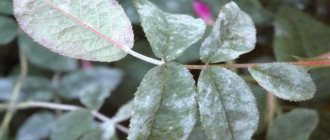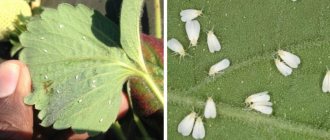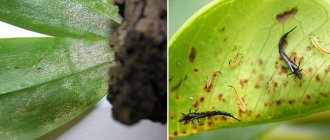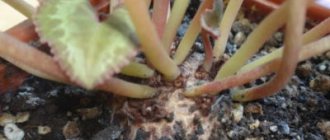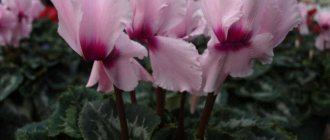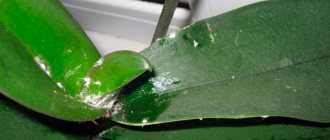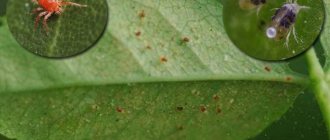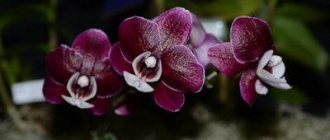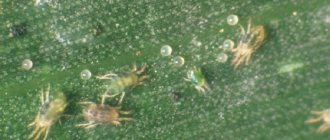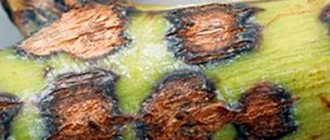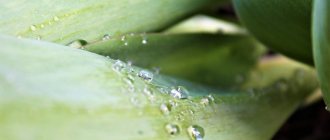Definition: what kind of parasite is this?
The scale insect (family Diaspididae) and the false scale insect (family Coccidae) are representatives of the order of homoptera insects of the suborder Coccidae. Insects feed on the sap of plants (household, garden and forest) from:
- leaves;
- shoots;
- fruits;
- branches;
- trunks.
Depending on the species, the body can be rounded or elongated. Color varies from light to dark brown. Sometimes there is a purple tint. The body of the scale insect is covered with a waxy shell, which is protection for the future generation.
False scale insects are distinguished by the fact that they do not have a shell, and the larvae and eggs are protected by the dying skin of the female. The size of the scale insects of adult insects does not exceed 5 mm, and the size of the false scale insects does not exceed 7 mm.
Insect larvae are called strays. When they hatch from eggs, they spread throughout the plant. Juveniles are oval-shaped, light yellow in color and very mobile. They have eyes, three pairs of legs and antennae.
Stragglers attach to leaves and stems. The limbs gradually die off.
Insects are covered with a dense wax shell. The color of the shell varies from white to brown. The larvae molt twice and develop into adult females and males. Males become mobile. They grow legs and wings, but their mouthparts are atrophied. After fertilization they die. Depending on the species, females lay eggs under the shield or give birth to larvae (up to 1000 pieces). Then they die.
Varieties of scale insects
In nature, there are about 2000 species of scale insects and false scale insects. Many of them can harm orchids. In addition to color, they can be distinguished from each other by the following characteristics:
- dimensions;
- the object on which they parasitize.
Most often, several varieties of scale insects can be found on orchids.
Palm scale
The most common type of scale insects on orchids
Females have a rounded waxy shield with a diameter of 1-2 mm. It is flattened, thin, brown in the center, and becomes light yellow at the edges. The diameter of the shield in males is 1 mm, but it is more elongated and has three longitudinal ridges. The carapace is densely covered with waxy whitish bristles. Males usually form colonies that form a cotton-like coating on the leaves.
The above-mentioned feature of males sometimes causes confusion, since mealybugs also form the same coating. They can be distinguished from each other by their characteristic appearance, as well as by the presence of female scale insects near the males. Thanks to waxy scales, insects live not only on the leaves, but also on the pseudobulb and rhizome.
Orchid purple scale
Adult female specimens are characterized by an oblong-oval shield 1-2 mm long. It is slightly convex and green-yellowish or brownish in color with slightly lightened edges. As the second molt stops, a large, voluminous ridge forms on the back. In adult male insects, the scutellum is even more elongated, but it is very small compared to that of female specimens. The sides of the shield most often do not reach 1 mm in length. The coloring coincides with that of females. In most cases, large colonies of insects can be found in the area of the base of the orchid leaf petiole.
Orchid red scale
In females, the shield is made in the shape of an almost perfect circle. It is convex and has a reddish-brown, almost dark color. The diameter of the shield is approximately 1.5-2 mm. The molting process begins at the convex seal in the middle of the larval scute and spreads out to the edges. As the molt progresses, the insects increase in size, while maintaining their original color. In males, the scutellum is exactly the same as in females, only its size is noticeably smaller.
The Florida red scale insect is almost identical to the pest category under consideration. The only significant difference is that the Florida scale insect is characterized by a tougher and rougher shell. The pest affects different types of orchids, but it causes the greatest harm to such varieties as:
- oncidium;
- cattleya;
Round orange scale
Adult females have a rounded shell, the diameter of which is approximately 2 mm. It is moderately convex, its color varies from brownish-red to almost black. An ash-gray color is found along the edges of the armor. During molting, the insect gets rid of the skin of the first two instars. Their middle part is painted brownish-reddish, the edging around the edges is lighter. In adult males, the scutum is lighter and too elongated.
Vanda scale insect
Females have a medium-convex, oval-shaped shield, no more than one and a half millimeters in length. The color of the shells is dark brown. On its surface in most cases there is a thin layer of dusty and waxy secretion. Males have the same shells, only smaller
How to determine its appearance?
Seeing the pest at the beginning of its development is a difficult task (due to its small size - 0.3 mm long).
- The first symptoms of scale insect infection are sticky orchid leaves. This is a sticky honeydew that clogs the pores and prevents the plant from breathing. The insect secretes it during its life.
- Then small yellow-brown tubercles appear, which are located on the leaf blades, young shoots and orchid flowers. Gradually the number of such yellow spots becomes larger.
Timely measures taken to destroy the pest will help save the orchid.
Appearance of the pest
Many gardeners have probably seen small brown bumps on the leaves and trunks of indoor plants. At first glance, they rather resemble miniature growths about 2–5 mm in size on plant organs, because they are completely motionless. However, they are not so harmless - a shield aphid, an insect from the family of hemipteran insects of the superfamily of scale insects, has undoubtedly settled on the flower.
In total, there are 2,400 species, which are united by a common feature - the presence of a shield, a kind of shell formed by a waxy secretion secreted by the pest. In some it is convex, round or oblong, firmly attached to the body, in others the shield is flat, easily separated, and they are usually called false shields. The color of the shield also varies and depends on the species - pale yellow, almost white-transparent, light or dark brown, almost black.
Males with a pair of wings and legs differ from females, which are motionless. Males have reduced oral organs, or rather, they are virtually absent; insects live for several days and die after fertilizing the female.
Female scale insects and larvae parasitize plants by piercing the plant tissue of indoor flowers with their proboscis and, having attached themselves more firmly, suck out the juice. In the process of their life, they secrete a viscous sweet liquid - honeydew. It attracts ants and serves as a suitable environment for the appearance of sooty fungi, which form a dark moldy coating that does not allow sunlight to reach the leaf blade and, thus, interferes with photosynthesis.
Pseudoscale insects do not produce honeydew, but they inject toxic substances into the plant tissue, which also paralyze the processes of photosynthesis.
Females lay up to 2–3 thousand eggs under the shield. From spring to autumn, two to three generations of mobile larvae are born: in the second half of May, July and September.
Therefore, at the beginning of each of these months, the orchid grower needs to carefully examine his home flowers, especially if new plants were purchased for the house from a flower shop or greenhouse.
The larvae very soon crawl along the leaf blades, find a place for themselves and stick tightly, secreting waxy threads and overgrown with a shield. The full life cycle of various types of pests is 45–65 days.
How to fight insects and cure a flower?
First it is necessary to carry out mechanical processing. Stages of orchid processing:
Thoroughly wash the window and window sill with disinfectants.- To catch active insects, use sticky tapes that are placed near the flower.
- Leaves and shoots with a degree of infection greater than 50% should be cut off.
- Replace topsoil.
- Wash the leaves and flower stalks with warm water using a soft brush and soapy water (to remove sticky honeydew).
- Dry the plant for 1-1.5 days.
- Carry out treatment using folk, biological or chemical means (depending on the degree of infection).
The treatment is repeated after 7-10 days.
Folk recipes
At the initial stage of infection, folk remedies are used:
| Means | Application |
| Garlic | Finely chop and apply to the insect attachment site, or rub with half a slice. |
| Garlic and soap |
|
| Onion | Rub the pest or fill the finely chopped onion with water and then spray the plant. |
| Alcohol | Spot-processed. But be careful, as it can cause leaf burn. |
| Vegetable oil | Two tablespoons per 1 liter of water. |
Biological agents
If folk remedies do not help, you can treat with biological or chemical agents.
| A drug | Action, application |
| I cheated | Causes death of eggs and larvae. It is necessary to spray so that the entire plant is covered with the preparation so that it “drips from the plant.” Till the soil thoroughly. |
| Fitoverm | It provokes paralysis of pests and they stop feeding. Death occurs on the third day after treatment. Full effect – after 6-7 days. |
| Nemabact | The nematode contained in the preparation integrates into the larva and destroys it. |
| Avertin | Leads to paralysis by affecting the nerve endings of parasites. |
Chemicals
| Insect | Appropriate use of drugs |
| Shchitovka | Intestinal and systemic action. |
| False shield | Intestinal, systemic and contact action. |
The absence of a durable shell in false scale insects does not prevent the penetration of contact poison.
| Name | A drug | Operating principle |
| Intestinal |
| They begin to act only after the pest enters the body. |
| System |
| The active substance enters the plant juice through the roots and leaves. Makes it poisonous to parasites. |
| Contact |
| Penetrates the body of pests through the skin. |
Biological and chemical agents must be used strictly according to the instructions. After any treatment, flowers should not be placed in direct sunlight, so as not to cause burns on the plant.
When using oil-based preparations, the solution is applied pointwise - only to the insect. If the product is sprayed, the pores on the leaves may become clogged, oxygen starvation and, as a result, the death of the plant.
Next, you can watch a useful video on how to deal with scale insects on an orchid:
Folk recipes
After preliminary measures, you can directly treat infected orchids from scale insects. Among the most popular and effective folk remedies are the following:
- Soap-alcohol solution. Add 15-20 g of liquid or laundry soap per liter of warm water, mix and pour in 10 ml of alcohol. Whip the mixture a little to make foam, and use a soft brush to apply it to the affected parts of the plants.
Important! It is extremely undesirable to spray soft and thin-leaved orchids with a soap-alcohol solution, since such varieties show increased sensitivity to any product containing alcohol!
- Oily liquid. To prepare it, you need to mix a couple of tablespoons of olive oil with a liter of water. The resulting product is used to spray infected flowers. In those areas where the spray jet does not penetrate, treatment is carried out using a brush.
- Garlic cloves. Divide the garlic cloves into pieces and wipe the damaged areas with the slices. You can also pass the garlic through a press and apply the resulting pulp with a toothbrush.
- Fern decoction. Pour 10 g of dry raw material or 100 g of fresh herb with water and leave at room temperature for a day. Then boil for half an hour, filter, let cool and spray the infected plants with the prepared product. Treatment must be carried out daily for a week.
Important! It is prohibited to use an infusion of hot pepper when treating orchids for scale insects, since these delicate plants will not tolerate such a stressful procedure!
Preparations made from natural ingredients work slowly, so the treatment will need to be repeated several times. In addition, do not forget that before starting the procedure, any of the above remedies must pass a test - apply the solution to a small area of one of the leaves and leave for several days. If during this time it does not lose its brightness and does not wither, it means that the orchid tolerates the chosen drug calmly and it can be used.
Prevention of re-infection
Preventative actions for the reappearance of pests are as follows:
- cure the orchid from other diseases (if any);
- create favorable conditions for growth and flowering (required level of lighting and humidity);
- If infected specimens are identified, immediately quarantine them and begin pest control;
- Keep “newcomers” in pots separately from other flowers (2 – 4 weeks).
If an orchid is infected with scale insects or false scale insects, urgent measures must be taken. Otherwise, the flower may die, and not only shed buds or leaves. Control methods depend on the personal preferences of the owner and the degree of infestation.
What danger does the insect pose?
Scale insects provoke the onset of sooty rot of the plant:
- The insect secretes a sticky liquid, which is an ideal environment for the appearance of fungi.
- Sticky feces disrupt photosynthesis processes and stop flowering.
- The false scale insect injects poison into the orchid, under the influence of which the leaves become covered with multi-colored spots.
- As the area of such spots increases, the leaf dies.
The affected plant is an excellent food for ants. The pest larvae quickly spread and infect neighboring bushes.
Biological agents: application features
These drugs are insects that eat scale insects. For example, varieties of wasps, ladybugs, beetles. But before using such insects, you need to clarify the type of pest, so you need to contact specialists for an accurate diagnosis. In addition, no one wants to have insects in the house (except in separate greenhouses or conservatories), so the use of biological agents is not always acceptable.
If the remedies do not help, you cannot remove the scale insects manually. During the procedure, you can raise the shields, under which there are still unhatched young individuals. Once the shield is damaged, they can spread very quickly.
Undesirable control measures
Some plant treatments used on other pests or plants are not suitable for scale insects on an orchid. Thus, you should not use preparations containing nitrogen, as well as root formation or growth stimulants:
- Epin;
- Zircon;
- indolylbutyric acid.
These drugs will have the opposite effect than expected and will increase the pest population. It is also not recommended to collect insects with your hands. This creates a risk of injury to the shell, as a result of which young larvae are selected from there and spread throughout the plant.
Mealybugs
You can find out about the presence of mealybugs on an orchid by plaque on the substrate, roots or inner walls of the pot. This cotton-like substance forms around female scale insects, which are always motionless. If you lift such a “yarn,” you can see both the insects themselves and their eggs. Most pests accumulate on flowers and peduncles, as well as on the inside of leaves.
Reason for appearance
The main reason for the appearance of mealybugs on an orchid is considered to be a violation of the conditions of detention. Weakened plants or specimens overfed with nitrogen fertilizers are much more susceptible to pest damage than healthy orchids.
How to get rid of mealybugs
Every day, morning and evening, you need to remove scale insects from the orchid using a toothpick or a soft thin stick. After this, the places where the insects were located must be treated with a cotton swab moistened with water or liquid soap.
Along with this, the substrate and the lower part of the orchid must be sprayed with Fitoverm (2 times at intervals of a week).
Treatment can be considered successful if not a single new insect is found on the orchid within a month.
Mealybug on an orchid flower
Folk remedies
An oily spray can help control mealybugs. It consists of 2 tbsp. olive oil and 1 liter of water. This emulsion should be sprayed onto the orchid using a sprayer.
Flower growers also speak well of an alcoholic solution with soap. It is made up of 15 g of liquid soap, 10 ml of denatured alcohol and 1 liter of water. Keep in mind that the product is not suitable for orchids with thin leaves.
When buying a new orchid, you need to carefully check it for pests, since there is always a risk of purchasing a plant that is already infested with mealybugs. The second important measure is periodic inspection of all specimens of the home flower garden. After all, once mealybugs settle on one plant, it will be extremely difficult to get rid of them. Don’t forget about proper care, the main components of which are good lighting and high air humidity.
